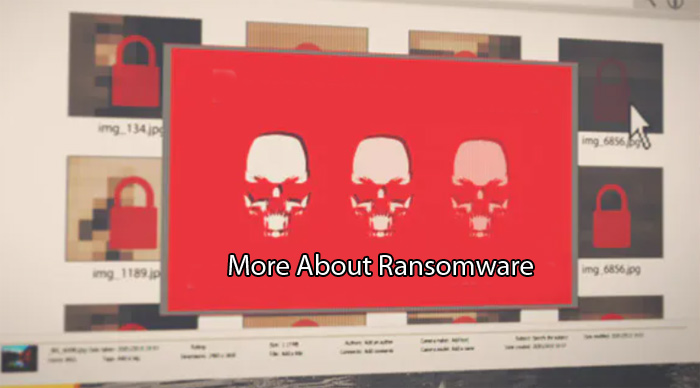
The modern internet is more like a jungle than a web. If you do not know the territory very well, expect to encounter an array of dangers and threats in your path. Get to know the internet-jungle better, and you might have the common sense to navigate the road forward with safety.
Ransomware has become one of the internet’s most feared threats. Where viruses aim at data destruction, ransomware turns user information into a hostage situation that plays off online.
Statistics from PurpleSec estimates that ransomware attacks are as common as every 14 seconds. According to the same resource, new ransomware saw an incredible 46% growth in 2019. Read more here.
Business and people are at an equal threat. If your data is important to you, cyber-criminals might exploit the vulnerability.
Here is what users navigating the internet should know about ransomware, and why it is a serious threat.
Getting To Know Ransomware
Ransomware is rife and might be found where users least expect it. Almost any link, download, or new online contact might lead straight to an attempted ransomware attack. First, get to know the potential threat behind ransomware.
What is Ransomware?
Ransomware is a type of virus that targets user information for ransom.
While there are a thousand different scenarios, that serves as a simple definition. The user information targeted could be anything. Usually, the data is anything a user would pay for to recover – or in some cases, stop from getting out.
Exploitation is a powerful negotiator. Unfortunately, ransomware takes full advantage of turning data into an online hostage negotiation.
Who Gets Targeted During Ransomware Attacks?
Ransomware can be aimed at anyone with data to protect.
Attacks and attempts are common in business, but also common for individual users. An added level of the ransomware exploit claims to have compromising details of the user to trade for cash.
The threat of forced data-recovery or public embarrassment pushes the user to cave in.
Hackers might demand anything, though the demands are usually asked-for in cryptocurrencies which might be difficult to track.
Who Is More Vulnerable To Ransomware Attacks?
If you are reading this, then you are potentially vulnerable to a ransomware attack. A situation like this could affect anyone with a device, internet connection, or information to protect.
However, certain things can make people more prone to being hit by ransomware attacks:
- Opening links that allow for nefarious software to gain access to your system.
- Installing apps or software that include illegal backdoors for hackers.
- Downloading from websites with ill-repute, where viruses could be hidden.
- Following ad-links online, where problems might be worse than just spam.
- Using older software, more vulnerable to being hacked than older versions.
- Engaging scammers, who might hide behind casual conversation while syphoning your data.
Basic security measures that barely seem like a second thought can drastically reduce your chances of viruses, malware, or ransomware. Guarantee they are a habit for everyone using your internet connection.
More About Ransomware

Ransomware preys on user desperation and pushes for a user’s eventual compliance. Users should remember that ransomware is more than just a threat, but also a crime.
1. How Does Ransomware Work?
Without having to explore lines of source code or the algorithms that make it work, most ransomware works on a simple concept. The software locks user data behind a randomly generated password; it is the equivalent of a software paywall for something you already own.
2. What Happens During Ransomware Threats?
The successful ransomware threat relies on eventual victim compliance. The victim panics, and the victim usually pays – in which case the scam has hit its target.
When the first reaction is embarrassment or panic, compliance is easier. That is the point.
3. What Can Users Do In The Event Of A Ransomware Threat?
If the typical ransomware attack happens to you, do not fall for it.
Law enforcement agencies are increasingly trained in how to spot and combat ransomware threats. Just like any other crime that might happen online, ransomware attempts should be reported immediately.
Some attempts are hollow threats, and some attempts are not. For the individual victim, it is almost impossible to tell. Both are considered a cyber-crime.
Further Protection Against Ransomware

Basic internet security measures can help to keep users and companies safer against online threats. Keyloggers, hackers, and ransomware often use the same techniques to exploit systems – and can be stopped in the same ways.
1. Always Use Top-Shelf Cybersecurity Software
A user’s level of cybersecurity is only ever as good as their software. Guarantee that your systems are running at their best, or you will be at an automatically higher risk for internet dangers.
2. Always Update System Software
Software in regular use should always be the most updated version. Without this, the user is almost as good as a sitting duck in the middle of the internet-jungle. Older software carries a higher risk of vulnerability or exploitation. It is never a good idea.
3. Always be Careful Online
Common sense is one of the most important things a user can do online. If a link or message does not feel “right”, do not click on it – and right there, you might have saved yourself a hundred cybersecurity threats. Guard your internet use, and you can guard your data better.















